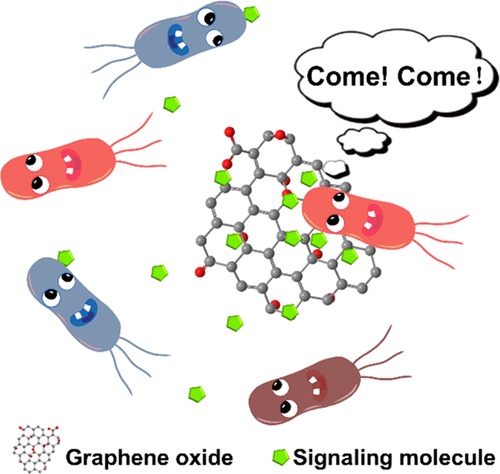当前位置:
X-MOL 学术
›
Nano Lett.
›
论文详情
Our official English website, www.x-mol.net, welcomes your
feedback! (Note: you will need to create a separate account there.)
Is Graphene Oxide a Chemoattractant?
Nano Letters ( IF 9.6 ) Pub Date : 2020-01-09 , DOI: 10.1021/acs.nanolett.9b05234 Chengdong Zhang 1 , Yaqi Wang 2 , Huiru Zhao 2
Nano Letters ( IF 9.6 ) Pub Date : 2020-01-09 , DOI: 10.1021/acs.nanolett.9b05234 Chengdong Zhang 1 , Yaqi Wang 2 , Huiru Zhao 2
Affiliation

|
The use of nanomaterials to regulate cell surface receptors is considered a novel strategy to manipulate cell behaviors. However, recognition is important to drive nanoparticle-cell complex formation. Here, we report a novel approach that uses graphene oxide (GO) as a chemoattractant to lure bacteria to nanosurface, facilitating complex formation. The amount of Escherichia coli (E. coli) cells attracted into capillaries containing 20 mg/L GO was more than 8.6-fold higher than that attracted into capillaries containing 20 mg/L glucose. The inherent mechanism involved interference with transmembrane chemoreceptors and activation of the chemotactic system via GO attachment and a subsequent increase in cell aggregation and migration via self-secreted quorum sensing molecules. The key feature of this strategy is the potential to improve the efficiency of the nanoparticle-cell recognition pattern and to expedite the development of surface-contact-related nanotechnology.
中文翻译:

氧化石墨烯是一种化学吸引剂吗?
使用纳米材料调节细胞表面受体被认为是一种控制细胞行为的新策略。然而,识别对于驱动纳米颗粒-细胞复合物的形成很重要。在这里,我们报告了一种新颖的方法,该方法使用氧化石墨烯(GO)作为化学引诱剂来诱使细菌进入纳米表面,从而促进复合物的形成。被含20 mg / L GO的毛细血管吸引的大肠杆菌细胞数量比含20 mg / L葡萄糖的毛细血管吸引量多8.6倍。内在机制涉及干扰跨膜化学感受器和通过GO附着激活趋化系统,并随后通过自分泌群体感应分子增加细胞聚集和迁移。
更新日期:2020-01-14
中文翻译:

氧化石墨烯是一种化学吸引剂吗?
使用纳米材料调节细胞表面受体被认为是一种控制细胞行为的新策略。然而,识别对于驱动纳米颗粒-细胞复合物的形成很重要。在这里,我们报告了一种新颖的方法,该方法使用氧化石墨烯(GO)作为化学引诱剂来诱使细菌进入纳米表面,从而促进复合物的形成。被含20 mg / L GO的毛细血管吸引的大肠杆菌细胞数量比含20 mg / L葡萄糖的毛细血管吸引量多8.6倍。内在机制涉及干扰跨膜化学感受器和通过GO附着激活趋化系统,并随后通过自分泌群体感应分子增加细胞聚集和迁移。











































 京公网安备 11010802027423号
京公网安备 11010802027423号